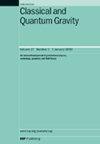GWSpace: a multi-mission science data simulator for space-based gravitational wave detection
IF 3.7
3区 物理与天体物理
Q2 ASTRONOMY & ASTROPHYSICS
引用次数: 0
Abstract
Space-based gravitational wave detectors such as TianQin, laser interferometer space antenna (LISA), and Taiji have the potential to outperform themselves through joint observation. To achieve this, it is desirable to practice joint data analysis in advance on simulated data that encodes the intrinsic correlation among the signals found in different detectors that operate simultaneously. In this paper, we introduce GWSpace, a package that can simulate the joint detection data from TianQin, LISA, and Taiji. The software is not a groundbreaking work that starts from scratch. Rather, we use as many open-source resources as possible, tailoring them to the needs of simulating the multi-mission science data and putting everything into a ready-to-go and easy-to-use package. We shall describe the main components, the construction, and a few examples of application of the package. A common coordinate system, namely the Solar System barycenter coordinate system, is utilized to calculate spacecraft orbits for all three missions. The paper also provides a brief derivation of the detection process and outlines the general waveform of sources detectable by these detectors.GWSpace:用于天基引力波探测的多任务科学数据模拟器
天基引力波探测器,如天琴、激光干涉仪空间天线(LISA)和太极有潜力通过联合观测超越自己。为了实现这一目标,需要提前对模拟数据进行联合数据分析,这些模拟数据对同时运行的不同探测器中发现的信号之间的内在相关性进行编码。在本文中,我们介绍了一个可以模拟天琴、LISA和太极联合探测数据的软件包GWSpace。这款软件并不是从零开始的突破性工作。相反,我们使用尽可能多的开源资源,根据模拟多任务科学数据的需要进行剪裁,并将所有内容放入一个现成的易于使用的软件包中。我们将描述该包的主要组成部分、结构和几个应用示例。一个共同的坐标系,即太阳系重心坐标系,被用来计算所有三个任务的航天器轨道。本文还提供了检测过程的简要推导,并概述了这些检测器检测到的源的一般波形。
本文章由计算机程序翻译,如有差异,请以英文原文为准。
求助全文
约1分钟内获得全文
求助全文
来源期刊

Classical and Quantum Gravity
物理-天文与天体物理
CiteScore
7.00
自引率
8.60%
发文量
301
审稿时长
2-4 weeks
期刊介绍:
Classical and Quantum Gravity is an established journal for physicists, mathematicians and cosmologists in the fields of gravitation and the theory of spacetime. The journal is now the acknowledged world leader in classical relativity and all areas of quantum gravity.
 求助内容:
求助内容: 应助结果提醒方式:
应助结果提醒方式:


